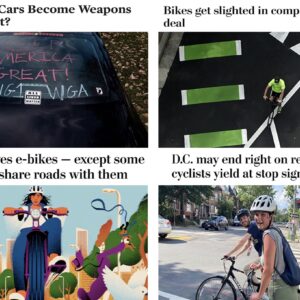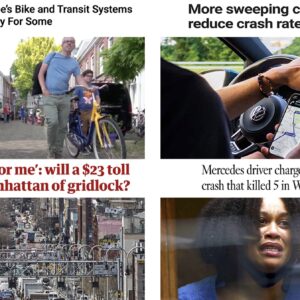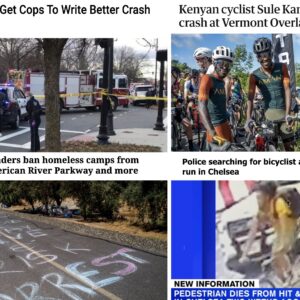Here are the interesting stories that caught my eye this past week…
— New York Times columnist Frank Bruni devoted a column to praise NYC Transportation Commissioner Jeannette Sadik-Khan. The piece has a lot of very vital lessons for Portland’s transportation and political leaders and it is quite relevant to our local situation. “So if a city believes that biking is part of a better future,” writes Bruni, “it must sometimes muscle through a reluctant, rocky present.” Expect more thoughts from me about this later in the week.
— Ending a nail-biter weekend for national bike advocates, the House and Senate have agreed on a “clean” extension of the federal transportation bill. That means key funding programs like Transportation Enhancements are safe for at least another six months.
— We’ve all cringed when people on bicycles are blamed in fatal crashes; but in this story, it was the bicycle itself that authorities say is to blame (not the officer’s 90 mph speed).
— Aren’t convinced that bicycling is on the rise in American cities? Even Los Angeles is beginning to make their streets more comfortable for people on bikes. Not sure if that project deserves this glowing headline; but it’s certainly an encouraging sign.
— USA Today says a whopping 1 in 7 people in the U.S. are driving cars without insurance (it’s just 1 in 10 in Oregon).
— More signs of success for bike-sharing in America. Boston’s system is going quite well.
— Ever heard people compare the plight of bicycling as low-man on the transportation totem pole to the struggle for civil rights? Well, it really annoys this I, Anonymous poster in the Portland Mercury (I have no idea which “white straight” blogger they could be referring to).
— “Are all drivers Socialists?” wonders Andrew Sullivan on The Daily Beast.
— With as much e-bike action as we have here in Portland, I continue to watch how the issues they raise unfold across the continent. In Toronto they’ve decided to ban e-assisted bicycles on one multi-use trail, much to the dismay of EV advocates.
— Portland resident and Treehugger columnist April Streeter wonders where we should draw the line when it comes to using sexy women to sell cycling.
— Several Portlanders made the trip to Guadalajara, Mexico this past week for the International Carfree Cities Conference. I can’t think of a better host city. Guadalajara has huge challenges to overcome, and at the same time has a very vibrant, creative, and effective activism culture. Check out the video below, “La cumbia de la bici” created for the conference by David Aguilar:





Thanks for reading.
BikePortland has served this community with independent community journalism since 2005. We rely on subscriptions from readers like you to survive. Your financial support is vital in keeping this valuable resource alive and well.
Please subscribe today to strengthen and expand our work.
One more reason (as if we needed another) to ban high speed chases and related nonsense by our police. Other countries don’t do it. Why do we?
So sorry to hear this story. My condolences to his family and community.
Wow. Emergency vehicles shouldn’t be allowed to go at a high rate of speed? Or fire and ambulance can go fast, but police should not?
If this is an instance where a crazy gunman is shooting patrons at an Ihop with an assault rifle (known to happen), should the officer only be allowed to go the speed limit? Or should they be limited to what you determine is a safe speed.
Maybe the police officer who evaded a bicycle was driving ‘too fast for conditions”?
http://tinyurl.com/3w2a7lx
“High speed police chases kill hundreds of people—including law enforcement officials, alleged criminals and innocent civilians—each year in the United States. The wrongful deaths and personal injuries caused by a police chase makes them one of top causes of car accidents. While authorities are engaged in high-speed police chases to capture a fleeing suspect, there can be a disregard for the safety of other drivers as officers continue the chase well after the danger outweighs the need to apprehend the suspect.
That is why two-thirds of those injured or killed in fatal car accidents stemming from a police chase are innocent drivers and pedestrians that have nothing to do with the chase.
Our car accident attorneys are especially sensitive to news involving police chases and are concerned that the police might be putting the public at risk when trying to catch someone who’s breaking the law.
Pursuits by law enforcement on the road are even more dangerous than commonly thought. More people in the United States are killed by high speed pursuits than they are by police firearms”
http://tinyurl.com/43xd2ab
The article stated the officer was responding to a call for help from another officer rather than being in a high speed chase. Without knowing the details of what the other officer was dealing with it is impossible to say if the speed was excessive.
I realize this wasn’t a high speed chase in the usual sense, but it fits I think neatly into the category of ridiculously fast maneuvers by police. Given that the police officer died at the scene and was going 90 mph it seems pretty obviously excessive to me.
Isn’t speed always excessive if the driver can’t respond safely to dangers in the road, such as a person walking across it? Or a large object right in the middle of it?
How can we justify police driving that endangers the others?
If the driver had been racing to reach a gunman in a public square across town, would that justify him running over grandma (pushing her grandbaby in a stroller) in order to get there faster?
I know that’s not what happened here, and that the victim in this case was the one driving (though someone else could easily have been killed had they been walking, biking, or pulled over to the side of the road in their car), but variations on these circumstances happen every day, an in no case would we say it was worth it when a death or injury was caused by the out-of-control driving of a police car.
I’m not suggesting the victim is to blame. Likely he was faithfully following his training and department policy. I am saying that the policy should not be tolerated.
I ride to Kelley Point Park a lot. So, I went for a nice Sunday eve cruise to check it out with Hempstalk going on.
Riding west on Marine Drive from the Expo Center, I started running into packs and herds of people walking, but no bicycles. The bike lanes on both sides of Marine Drive were turned into parking, but the bike path was full of people, so I just rode in the lane.
Once I got to the Kelley Point entrance, I rode through and past hundreds of walkers on the entrance road. You know you’re conditioned to Portland events when you ask a couple Event Staff guys where the bike parking is. Turns out there wasn’t any at Hempstalk. “Uh, maybe lock it to the fence backstage like you belong there?” Which is funny, because the one permanent bike rack by the bathroom was in the fenced-off backstage area. Out of thousands of people, I counted just a few bikes. Though I did lock up to a sign post by someone’s Surly. Sometimes we forget about other groups of people in town. Not all of Portland is bike-centric, especially not the hemp-centric culture.
Still, I can’t belive how many people WALKED the 5 miles from the Expo Center to Kelley Point, and then back. The alternative was a $2 shuttle ride…or a bike!
Yeah, I saw all those people walking and thought, “man, that’s nuts! It’s so far, and a bike would cut the trip into a third of the time or more.”
The Sadik-Khan piece was illustrative — Portland totally lacks this necessary leadership. Some of us would rather kiss 18-year old boys, others would rather cow-tow to the PPB, and still others would rather write blog posts. Regardless, in a town where it’s more important to be nice than right, don’t expect PDX to catch up with NYC any time soon.
I would like to see E-bikes banned from bicycle lanes in town. An e-bike is nothing more than a slightly smaller motorcycle or scooter. To me the dividing line is human powered or motor powered. Motor powered vehicles belong in the traffic lane not the bicycle lane.
What about people that are disabled, and can’t pedal a bike? Should they be prevented from having access to MUP’s and bike trails even though an ebike would enable that access for them? Maybe the DMV should offer special permits for disabled people to ride ebikes, as they allow permits for such people to park in their cars closer to store entrances.
Because the nature of the bikes lend themselves to it, it’s likely that numbers of people, but not all of them having need of using ebikes, will abuse the ease of travel that ebikes enable.
It’s great to have more people on bikes instead of driving a car, to the extent this would be an accomplishment of ebikes, but more lazy, pushy and obnoxious people on bike paths and MUP’s isn’t the kind of element that’s going to create a welcoming riding environment there, for people interested in riding on the power of their own muscles.
“…Maybe the DMV should offer special permits for disabled people to ride ebikes, as they allow permits for such people to park in their cars closer to store entrances. …” wsbob
I’m glad to read that people reading here, see some merit in that idea. One caveat that has to be mentioned along with such and idea, is that it seems the handicapped permits issued to people that drive, have been notoriously abused by people that either have recovered and no longer qualify for them, or by other people that have no handicap whatsoever (relative, friend, etc. ), and aren’t using the vehicle in any way associated with transporting handicapped persons.
The media has done some stories about this abuse, and there have been efforts to fight the abuse, but apparently, it’s kind of tough nut to crack. Convenient parking is hard to resist, as I suppose, motor vehicle free short cuts via MUP’s and bike lanes would be to a lot of people attracted to effortless travel by ebike.
I fully agree.
Assisted bikes, segways, rascal scooters, etc. do not belong in the bike lane or on the sidewalk.
Unless of course they are operated by a handicapped person with a permit.
I’d like to see an E-bike ban law that explicitly forbids use in all places where they are likely to harm more vulnerable road and path users. With potential for a BIG fine and or jail time.
THEN – publicly announce that this law will only be enforced in situations where there are complaints and or damages.
If an E-bike user is polite and cautious enough to slow down to safe speeds around HPVs and pedestrians then there is no harm.
If, on the other hand, an E-bike user (or even an unassisted cyclist) physically endangers they get one warning at most then gets hammered.
When a road user, no matter the mode, displays an inability or unwillingness to share the road in a safe and courteous manner then it is the job of society to rectify the situation.
12 mph limits on MUPs, enforced.
I’d be willing to bet that standard bikes are in more accidents than E-bikes.
I agree with Craig: 12 mph speed limit for bicycles and adult trikes.
Dabby’s right to: no disabled people on our MUP’s unless they have a permit.
Enforced? How could a speed limit for a designated speed for ebikes be practically enforced? How much would it cost to enforce speed limits for ebikes?
Good question. Same goes for enforcement on the roadways. Why don’t we have a rigorous system of traffic enforcement (speed, crosswalks, etc.) that would create safer conditions and would easily pay for itself? I’m aware of the pitfalls related to abuse of enforcement for revenue gain, but those problems could be pre-solved through intelligent planning.
@wsbob
(and not only limited to e-bikes, but all users of MUP’s)
Reckless riding on a bicycle or motorized vehicle should be punished.
There is a huge infrastructure in place for motorized vehicles. Even slow motorized vehicles should not be allowed in human powered bicycle lanes. If we accept slow motorized vehicles, what would keep a someone from driving a Harley in the bike lane as long as they were going slow?
“…If we accept slow motorized vehicles, what would keep a someone from driving a Harley in the bike lane as long as they were going slow? …” Jon
Relative to use of ebikes on bike lanes, and MUP’s, what would be an acceptable ‘slow’ speed for them on these public ways?
Going slow, especially on a bike trail or a MUP is probably the last place any Harley rider would ever want to ride their bike. On the other hand, owners of scooters with small displacement motors…50cc or so…or electric scooters…might be very interested in having access to MUP’s and bike lanes…possibly some bike and hiking trails too.
What to conventional users of those public ways represents an intrusion or even a danger, to users of ebikes and small fuel powered scooters, represents means of potential access to places they wouldn’t otherwise have access to.
The Toronto article…link provided in the roundup….is short but introduces some issues that are very relevant to the availability and use of ‘e’ associated vehicles; that they’re consistent with “…with the shift to greener ways of travel…”, which indirectly suggest that by means of that rationale, their access to MUP’s and bike lanes should possibly be considered.
The article also points up the fact that because of ebike availability and use, a need to more clearly define what constitutes a bike, is a compelling need. Article reports that several years ago, Toronto wrote a bylaw using the phrase ‘muscular power’ to make that distinction: “…restricts the use of bike paths to bicycles, defined as vehicles operating solely on “muscular power,…”. This sentence excerpt also includes the word ‘solely’, which excludes e-assist bikes.
I imagine many people are conflicted about ideas of whether people that are legitimately using at least some of their muscular power to transport themselves around on a bike, should be excluded from bike lanes and MUP’s because they’re also using a motor to help them along at points on their ride.
I figure any mode whose potential (i.e. weight & speed capability) to do damage falls below a prescribed threshold could be allowed on MUP’s. Would that mean licensing e-bikes, with license classifications just like motorcycle licenses, which would differentiate e-bikes that are capable of exceeding 15mph on the flat from those that are not?
Call me daft, but I really think there’s a place in progressive urban planning and in vehicle design/marketing for cars/scooters/mopeds/e-bikes that are built to be underpowered such that they can only attain lower/safer speeds appropriate to city streets/MUPs/etc.
And this ultimately is my point: it is the user, NOT THE MODE, that make the roads and paths dangerous. Thus the ecosystem that has developed and will continue to exist is one of where there is not enough enforcement to prevent, only to put out fires.
This holds true for autos, bicycles, pedestrians, runners, pets, large trucks and E-bikes.
Would it be nice if everyone followed the rules and was polite: OF COURSE!
Can we expect people to follow the herd politely when we’ve built a society based on NOT following the herd and not conforming? No, not really
Only when user behavior becomes dangerous enough will it be curtailed. Some people call this freedom.
…or dangerous enough to one’s wallet…
Sadly for me and other speed demons the correct answer is “as slow as the most vulnerable road/path user feels is safe. Not the fast user, but the slow user. In this way it would be legally be prosecuted like sexual harrasment is in the corporate field: it isn’t a matter of intent of the accused but affect on the victim.
In this case a legislated ban that is almost unenforced creates a “fake politeness” where illegal users are encouraged not to be seen disobeying the law or to be seen doing so in as nonthreatening a manner as possible.
This is not a long term sustainable solution as it effectively creates 2nd class users but I can hope that the problems don’t manifest until after crude oil prices exceed the magic price where automotive use declines making main roads the viable alternative.
I’d guess that of all bicycle crashes that occur a larger proportion occur when a cyclist misinterprets the intended path of a pedestrian than auto vs bicycle collisions. Because so little inertial energy is at play in bike vs ped collisions they are likely very under-reported and their ultimate impact on the non-cycling psyche is under-appreciated.